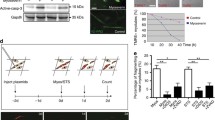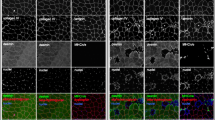Summary
We test the proposal (McGeachie and Grounds 1985) that myogenesis following severe (crush) injury is prolonged compared with minor (cut) injury. Forty-four mice were injured with a cut and a crush lesion on different legs, and tritiated thymidine was injected at various times after injury (0 to 120 h), samples of regenerated muscle were taken 9d after injury and autoradiography was used to determine the initiation of muscle precursor replication, and duration of proliferation after the two different injuries.
In both lesions replication of potential myoblasts was initiated 30 h after injury. Myogenesis was essentially completed in cut lesions by 96 h after injury, although the peak was finished by 60 h. In contrast, significant muscle precursor replication in crush lesions was still occurring 96 h after injury, and myogenesis was almost finished by 120 h. The pronounced difference in duration of myogenesis in different lesions strongly supports the original proposal
The extended duration of myogenesis in crush lesions, in conjunction with tritiated thymidine reutilisation, appears to account for conflicting experimental results in support of the concept of a circulating muscle precursor cell.
Similar content being viewed by others
References
Allbrook DB (1981) Striated muscle regeneration. Muscle Nerve 4:234–245
Bateson RG, Woodrow DF, Sloper JC (1967) Circulating cell as a source of myoblasts in regenerating injured mammalian skeletal muscle. Nature 213:1035–1036
Bintliff S, Walker BE (1960) Radioautographic study of skeletal muscle regeneration. Am J Anat 106:233–245
Carlson BM (1973) The regeneration of skeletal muscle — a review. Am J Anat 137:119–149
Carlson BM, Faulkner JA (1982) The regeneration of skeletal muscle fibres following injury. Med Sci Sports Exerc 15:187–198
Dilley R, McGeachie J (1983) Block staining with p-phenylenediamine for light microscope autoradiography. J Histochem Cytochem 31:1015–1018
Durante G (1902) Anatomie pathologique de la fibre musculaire striées: chronologie de la régénération musculaire. In: Cornil V, Ranvier L (eds) Manuel d' histologie pathologique 2:92–96
Field EJ (1960) Muscle regeneration and repair. In: Bourne GH (ed) The structure and function of muscle. Acad Press, NY, p 139–170
Grounds MD, McGeachie JK (1987a) A Model of myogenesis in vivo, derived from autoradiographic studies of regenerating skeletal muscle, challenges the concept of quantal mitosis. Cell Tissue Res (in press)
Grounds MD, McGeachie JK (1987b) Reutilisation of tritiated thymidine in studies of regenerating skeletal muscle. Cell Tissue Res (in press)
Jirmanova I, Thesleff S (1972) Ultrastructural study of experimental muscle degeneration and regeneration in the adult rat. Z Zellforsch 131:77–97
Lash JW, Holtzer H, Swift H (1957) Regeneration of mature skeletal muscle. Anat Rec 128:679–698
Le Gros Clark WE (1946) An experimental study of the regeneration of mammalian striped muscle. J Anat 80:24–36
Maltin CA, Harris JB, Cullen MJ (1983) Regeneration of mammalian skeletal muscle following injection of snake venom, taipoxin. Cell Tissue Res 232:565–577
Mauro A (1961) Satellite cells of skeletal muscle fibres. J Biophys Biochem Cytol 9:493–495
McGeachie JK, Grounds MD (1985) Can cells extruded from denervated skeletal muscle become circulating potential myoblasts? Implications of3H-thymidine reutilization in regenerating muscle. Cell Tissue Res 242:25–32
McGeachie JK, Grounds MD (1986) Cell proliferation in denervated skeletal muscle: does it provide a pool of potentially circulating myoblasts? Bibl Anat 29:173–193
Pietsch P (1961) The effects of colchicine on regeneration of mouse skeletal muscle. Anat Rec 139:167–172
Reznik M (1970) Satellite cells, myoblasts, and skeletal muscle regeneration. In: Mauro A, Shafiq SA, Milhorat AT (eds) Regeneration of striated muscle and myogenesis. Exerpta Medica. Amsterdam, p 133–156
Reznik M (1971) Experimental muscle regeneration in animals. In: Kakulas BA (ed) Basic research in myology. Exerpta Medica, Amsterdam, p 420–425
Sloper JC, Bateson RG, Gutierrez M, Hindle D, Warren J (1970) Muscle regeneration in man and mouse; a study based on tissue culture, on the use of tritiated thymidine, and on the preinjury irradiation of crushed muscle. In: Walton JN, Canal N, Scarlato G (eds). Muscle Diseases. Excerpta Medica, Amsterdam, 357–364
Zhinkin LN, Andreeva LF (1963) DNA synthesis and nuclear reproduction during embryonic development and regeneration of muscle tissue. J Embryol Exp Morphol 11:353–367
Author information
Authors and Affiliations
Rights and permissions
About this article
Cite this article
McGeachie, J.K., Grounds, M.D. Initiation and duration of muscle precursor replication after mild and severe injury to skeletal muscle of mice. Cell Tissue Res. 248, 125–130 (1987). https://doi.org/10.1007/BF01239972
Accepted:
Issue Date:
DOI: https://doi.org/10.1007/BF01239972




